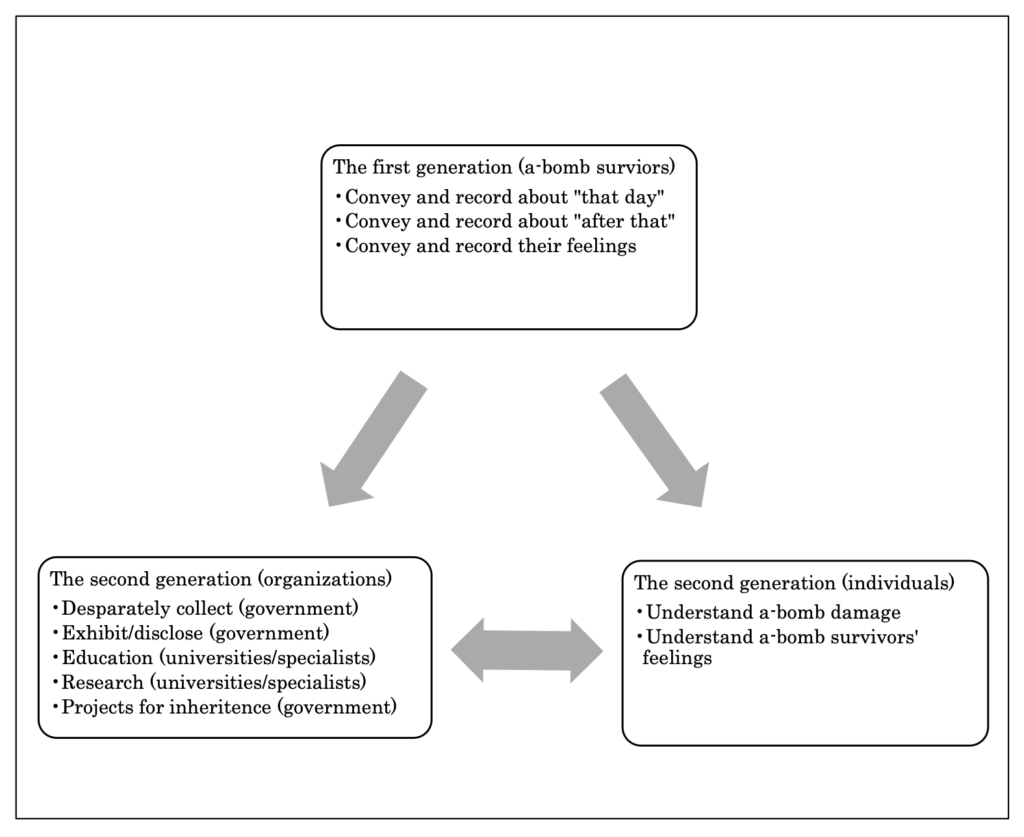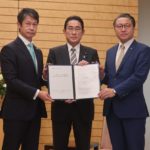4 Proposals
As the next generation, who did not experience the a-bomb, what will we inherit and pass on? For example, no matter how “that day” is handed down by survivors, it is impossible to understand the hell-like scenes with reality. If so, as with a typical idea, we must understand “that day” through videos, photos, testimonies and notes using our full imaginations. For inheritance, fundamental understanding is essential. The same can be said of “after that” and “thoughts and wishes”.
In that case, the key is how we can undertake initiatives for understanding. Also, regarding such initiatives, there are two levels: individuals and organizations. As an attempt, I have summarized the initiatives intended for a-bomb experience inheritance in the following chart. The first generations who experienced the a-bombs focus on handing down, conveying and recording their experiences, various harm to their health caused by atomic bomb radiation, psychological damage, and their thoughts. Organizations desperately try to collect and organize (compile databases) such testimonies, notes and materials to put them in public.
Graph 2 Initiatives for inheritance

As mentioned earlier, Hiroshima City and Hiroshima Peace Culture Foundation have developed various projects to inherit and pass on the experience of the atomic bombing. One example is “The A-bomb Legacy Successors Training Project.” This project launched in 2012 and received 137 entries in the first year 21). Currently, 88 successors are working after completing three-year training. In order to support this project, Hiroshima City has budgeted for it from 2017 and started regular talks by a-bomb legacy successors 22). Besides educating a-bomb legacy successors, this project is useful to increase people who understand the harm caused by the a-bomb. In addition, to collect a-bomb artifacts, testimonies and remnants, which the Hiroshima Peace Memorial Museum has been doing for many years, is also important. It is hoped that projects such as a-bomb experience testimony, talks by a-bomb legacy successors and Hiroshima Peace Volunteers, which are some of the major roles of the museum, will be continued in the future.
Regarding a-bomb testimonies and notes, the Hiroshima National Peace Memorial Hall for the Atomic Bomb Victims has been engaged in projects. They steadily collected the records of a-bomb testimonies and photos of deceased people and compiled a data base. As of March 31, 2017, 135,747 testimonies were organized and 21,629 photos and names were collected. These materials are shared in a variety of ways. In addition, there are diverse projects for inheritance, such as a-bomb survivor testimonies for students, Hiroshima Peace Volunteers, filming testimony videos (joint-project with the National Peace Memorial Hall for Atomic Bomb Victims), compiling data bases on peace, etc. There is no shortage of examples of these activities and projects. It is necessary to continue these projects, however, at the same time, it is also important that many people access these projects.
According to a report by the Hiroshima Peace Culture Foundation in 2016, the number of visitors to the Hiroshima Peace Memorial Museum that year was approximately 1.74 million, marking the highest number on record. In addition, the number of visitors to the Hiroshima National Peace Memorial Hall for the Atomic Bomb Victims numbered more than 341,000. However, taking account of the fact that the total number of tourists to Hiroshima in the same year increased by 5.1%, reaching 12 million 611 thousand 23) and that the visitors to Miyajima numbered about 4.3million 24), it cannot be said that the number of visitors to both institutes is large. It is necessary to create a flow line for “peace sightseeing” that starts from visiting the Atomic Bomb Dome, then Peace Memorial Park and its neighboring areas, Hiroshima Peace Memorial Museum, Hiroshima National Peace Memorial Hall for the Atomic Bomb Victims and viewing the monuments dotted throughout the park 25).
On the other hand, the role of researchers is not small. Regarding elucidation of the delayed effects of the atomic bomb, research has been assiduously conducted in the field of medical science, and incidental risks caused by radiation have been clarified. Although it is still ongoing, research on the molecular mechanism of carcinogenesis caused by atomic bomb radiation has made huge progress. Regarding the psychological damage, social influence and thoughts of a-bomb survivors, we have dealt with them utilizing surveys by newspaper companies. Concerning these research results, it is important that they are not only provided to educational institutes but also offered widely for citizens setting up opportunities for public lectures.
At Hiroshima University, to which the authors belong, we began offering Peace Science classes in 2011 26) and made them compulsory. As a result, nearly 2,500 new students will all take these classes. In 2017, we conducted 29 Peace Science classes. Out of the 29 classes, 20 classes, which corresponds to about 70%, incorporate themes such as “the atomic bomb,” “radiation exposure (including exposure to non-atomic bomb radiation)” and “nuclear weapons.” In some classes, a-bomb survivors have been invited to testify. Peace education about the atomic bombing in elementary through high school is important, and also, it is significant to learn further about the harm caused by the atomic bomb in more specialized classed at higher education institutes such as universities. After understanding the harm of the atomic bomb to some extent at schools and then listening to lectures by a-bomb survivors and reading testimonies, students can observe notes and a-bomb artifacts. Alternatively, they can listen to the testimony and then learn a-bomb more scientifically. By going through these process, understanding of the harm caused by the a-bomb will definitely deepen. By continuously engaging in these processes we can ensure the inheritance of the a-bomb experience.
It is necessary for government and universities to take their responsibilities fully, and at the same time, to provide opportunities for deepening understanding of the a-bomb experience through cooperation. In doing so, cooperation between government and universities is essential. Hiroshima Peace Culture Foundation and Hiroshima University concluded a comprehensive collaboration agreement in December 2016.
As part of the agreement, we plan to conduct extension lectures intended for citizens. By combining academic research results and various a-bomb artifacts, it is hoped understanding of the a-bomb’s harmful effects will deepen. As mentioned at the beginning, many a-bomb survivors think that the a-bomb experience is not sufficiently inherited. They feel that it is difficult to understand the complexity of the harm caused by the bomb, including the delayed effects of the bomb which last many years, and health concerns and social damage attributable to them, and the experience of “that day” when the a-bomb was dropped. How can we academically study the entire picture of such complicated and continuous damage and how can we provide citizens with the research results through cooperation? This is one of the missions imposed on universities and the government.
Finally, I would like to point out the necessity of taking special notice of a-bomb survivors’ thought on “a nuclear-free world” based on their a-bomb experience. Their feeling that a-bomb experience is not inherited is associated with the feelings that peace movements centered on “a nuclear-free world” have not been improved so far after “the lost decade.” As discussed in another paper (Kawamoto et.al., 2016), more than half of the a-bomb survivors are skeptical about the realization of “a nuclear-free world.” The current situation in which a-bomb survivors feel a nuclear-free world is not realized or is not expected is related to their feelings that the a-bomb experience has not been transmitted.
Hiroshima, which advocates “a nuclear-free world,” is entering an era where it can no longer rely upon a-bomb survivors to bear the burden of their message. Do we plan to realize “a nuclear-free world” or will we take larger responsibilities as a hallowed ground of peace? Thinking and clarifying the future and role of Hiroshima once again is an indispensable element in inheriting the a-bomb experience.
21) The breakdown was: 15 atomic bomb survivors (among whom two had been in utero at the time), the offspring of bomb survivors (50), the grandchildren of survivors (4), and 68 others.
22) The initial budget for 2017 was over 3,591,000 yen. Hiroshima Peace Memorial Museum, outside of holidays, is open to the public every day. For details, see the following URL: http://hpmmuseum.jp/modules/info/index.php?action=PageView&page_id=148 (accessed January 26th, 2018)
23) Announcement by Hiroshima City Board of Tourism. (Accessed January 26th, 2018.) http://www.city.hiroshima.lg.jp/www/contents/1496238527600/files/kankokyaku.pdf
24) Announcement by Hatsukaichi City. https://www.city.hatsukaichi.hiroshima.jp/uploaded/attachment/20634.pdf (Accessed January 26th, 2018)
25) The authors have studied Peace Memorial Park, the Atomic Bomb Dome, and have studied peace, as it’s called, and want to put Peace Tourism in its proper context. That possibility has been discussed in the previously mentioned international symposium under the auspices of Hokkaido University. A summary of the contents of that event is due to be written up by another author.
26) For Peace subjects, we recommend “Hiroshima’s Path to Reconstruction,” a supplementary reader compiled by Hiroshima Prefecture and Hiroshima City in connection with The Hiroshima Global Peace Plan.




